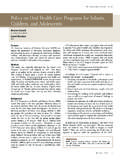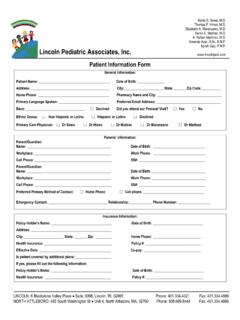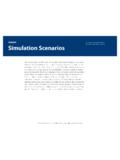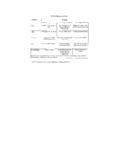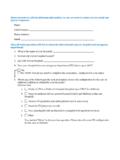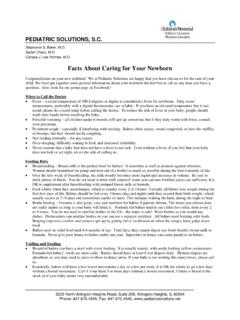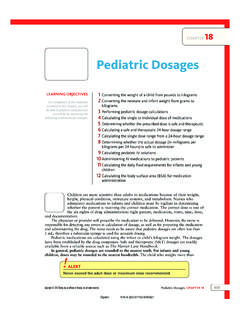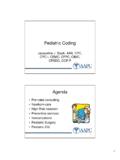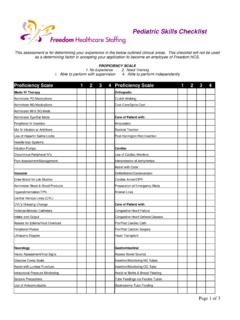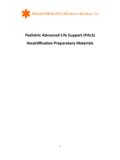Transcription of Use of Antibiotic Therapy for Pediatric Dental …
1 AMERICAN ACADEMY OF Pediatric DENTISTRYRECOMMENDATIONS: BEST PRACTICES 371 PurposeThe American Academy of Pediatric Dentistry (AAPD) recog-nizes the increasing prevalence of Antibiotic -resistant micro- organisms. This guideline is intended to provide guidance in the proper and judicious use of Antibiotic Therapy in the treatment of oral guideline was originally developed by the Council on Clinical Affairs and adopted in 2001. This document is a revision of the previous version, last revised in 2009. The re- vision was based upon a new systematic literature search of the PubMed /MEDLINE database using the terms: Antibiotic Therapy , antibacterial agents, antimicrobial agents, Dental trau- ma, oral wound management, orofacial infections, periodontal disease, viral disease, and oral contraception; fields: all; limits: within the last 10 years, humans, English, clinical trials, birth through age 18.
2 One hundred sixty-five articles matched these criteria. Papers for review were chosen from this search and from hand searching. When data did not appear sufficient or were inconclusive, recommendations were based upon expert and/or consensus opinion by experienced researchers and clinicians. Background Antibiotics are beneficial in patient care when prescribed and administered correctly for bacterial infections. However, the widespread use of antibiotics has permitted common bacteria to develop resistance to drugs that once controlled Drug resistance is prevalent throughout the Some microorganisms may develop resistance to a single anti- microbial agent, while others develop multidrug-resistant ,3 To diminish the rate at which resistance is increas- ing, health care providers must be prudent in the use of use of antibiotics is indicated to minimize the risk of developing resistance to current Antibiotic .
3 3 Practitioners should adhere to the following general princi- ples when prescribing antibiotics for the Pediatric wound managementFactors related to host risk ( , age, systemic illness, malnu- trition) and type of wound ( , laceration, puncture) must be evaluated when determining the risk for infection and subsequent need for antibiotics. Wounds can be classified as clean, potentially contaminated, or contaminated/dirty. Facial lacerations may require topical Antibiotic Intraoral lacerations that appear to have been contaminated by extrinsic bacteria, open fractures, and joint injury have an increased risk of infection and should be covered with If it is determined that antibiotics would be beneficial to the healing process, the timing of the administration of antibiotics is critical to supplement the natural host resistance in bacterial killing.
4 The drug should be administered as soon as possible for the best result. The most effective route of drug administration (intravenous vs. intramuscular vs. oral) must be considered. The clinical effectiveness of the drug must be monitored. The minimal duration of drug Therapy should be five days beyond the point of substantial improvement or resolution of signs and symptoms; this is usually a five- to seven-day course of treatment dependent upon the specific drug In light of the growing problem of drug resistance, the clinician should consider altering or discontinuing antibiotics following determination of either ineffectiveness or cure prior to com- pletion of a full course of If the infection is not respon- sive to the initial drug selection, a culture and susceptibility testing of isolates from the infective site may be indicated.
5 Special conditionsPulpitis/apical periodontitis/draining sinus tract/localized intra-oral swellingBacteria can gain access to the pulpal tissue through caries, exposed pulp or dentinal tubules, cracks into the dentin, and defective restorations. If a child presents with acute symptoms of pulpitis, treatment ( , pulpotomy, pulpectomy, or extrac- tion) should be rendered. Antibiotic Therapy usually is not indicated if the Dental infection is contained within the pulpal tissue or the immediate surrounding tissue. In this case, the Review CouncilCouncil on Clinical AffairsLatest Revision2014 Use of Antibiotic Therapy for Pediatric Dental PatientsABBREVIATION AAPD: American Academy Pediatric Dentistry. 372 RECOMMENDATIONS: BEST PRACTICESREFERENCE MANUAL V 39 / NO 6 17 / 18child will have no systemic signs of an infection ( , no fever and no facial swelling).
6 9,10 Consideration for use of antibiotics should be given in cases of advanced non-odontogenic bacterial infections such as staphylococcal mucositis, tuberculosis, gonococcal stoma- titis, and oral syphilis. If suspected, it is best to refer patients for culture, biopsy, or other laboratory tests for documentation and definitive facial swelling of Dental originA child presenting with a facial swelling or facial cellulitis sec- ondary to an odontogenic infection should receive prompt Dental attention. In most situations, immediate surgical inter-vention is appropriate and contributes to a more rapid The clinician should consider age, the ability to obtain adequate anesthesia (local vs. general), the severity of the infection, the medical status, and any social issues of the ,12 Signs of systemic involvement ( , fever, asymmetry, facial swelling) warrant emergency treatment.
7 Intravenous Antibiotic Therapy and/or referral for medical management may be Penicillin remains the empirical choice for odontogenic infections; however, consideration of additional adjunctive antimicrobial Therapy ( , metronidazole) can be given where there is anaerobic bacterial traumaSystemic antibiotics have been recommended as adjunc-tive Therapy for avulsed permanent incisors with an open or closed Tetracycline (doxycycline twice daily for seven days) is the drug of choice, but consideration of the child s age must be exercised in the systemic use of tetracycline due to the risk of discoloration in the developing permanent ,14 Penicillin V or amoxicillin can be given as an ,15,17 The use of topical antibiotics to induce pulpal revascularization in immature non-vital traumatized teeth has shown some ,15,17,18 However, further random-ized clinical trials are For luxation injuries in the primary dentition, antibiotics generally are not ,23 Antibiotics can be warranted in cases of concomitant soft tissue injuries (see Oral wound management)
8 And when dictated by the patient s medical periodontal diseasesDental plaque-induced gingivitis does not require Antibiotic Therapy . Pediatric patients with aggressive periodontal diseases may require adjunctive antimicrobial Therapy in conjunction with localized In Pediatric periodontal diseases associated with systemic disease ( , severe congenital neutro- penia, Papillon-Lef vre syndrome, leukocyte adhesion defi- ciency), the immune system is unable to control the growth of periodontal pathogens and, in some cases, treatment may involve Antibiotic ,25 The use of systemic antibiotics has been recommended as adjunctive treatment to mechanical debridement in patients with aggressive periodontal ,25 In severe and refractory cases, extraction is ,25 Cul- ture and susceptibility testing of isolates from the involved sites are helpful in guiding the drug.
9 25 Viral diseasesConditions of viral origin such as acute primary herpetic gin- givostomatitis should not be treated with Antibiotic Therapy unless there is strong evidence to indicate that a secondary bacterial infection gland infectionsMany salivary gland infections, following confirmation of bacterial etiology, will respond favorable to Antibiotic Therapy . Acute bacterial parotitis has two forms: hospital acquired and community Both can be treated with antibiotics. Hospital acquired usually requires intravenous antibiotics; oral antibiotics are appropriate for community acquired. Chronic recurrent juvenile parotitis generally occurs prior to puberty. Antibiotic Therapy is recommended and has been For both acute bacterial submandibular sialadenitis and chro- nic recurrent submandibular sialadenitis, Antibiotic Therapy is included as part of the Oral contraceptive useWhenever an Antibiotic is prescribed to a female patient taking oral contraceptives to prevent pregnancy, the patient must be advised to use additional techniques of birth control during Antibiotic Therapy and for at least one week beyond the last dose, as the Antibiotic may render the oral contraceptive ,29 Rifampicin has been documented to decrease the effectiveness of oral ,29 Other antibiotics, particularly tetracycline and penicillin derivatives.
10 Have been shown to cause significant decrease in the plasma concentra- tions of ethinyl estradiol, causing ovulation in some individuals taking oral ,29 Caution is advised with the concomitant use of antibiotics and oral ,29 References 1. Wilson W, Taubert KA, Gevitz M, et al. Prevention of in-fective endocarditis: Guidelines from the American Heart Association A Guideline From the American Heart As-sociation Rheumatic Fever, Endocarditis and Kawasaki Disease Committee, Council on Cardiovascular Disease in the Young, and the Council on Clinical Cardiology, Council on Cardiovascular Surgery and Anesthesia Anes- thesia, and the Quality of Care and Outcomes Research Interdisciplinary Working Group.

